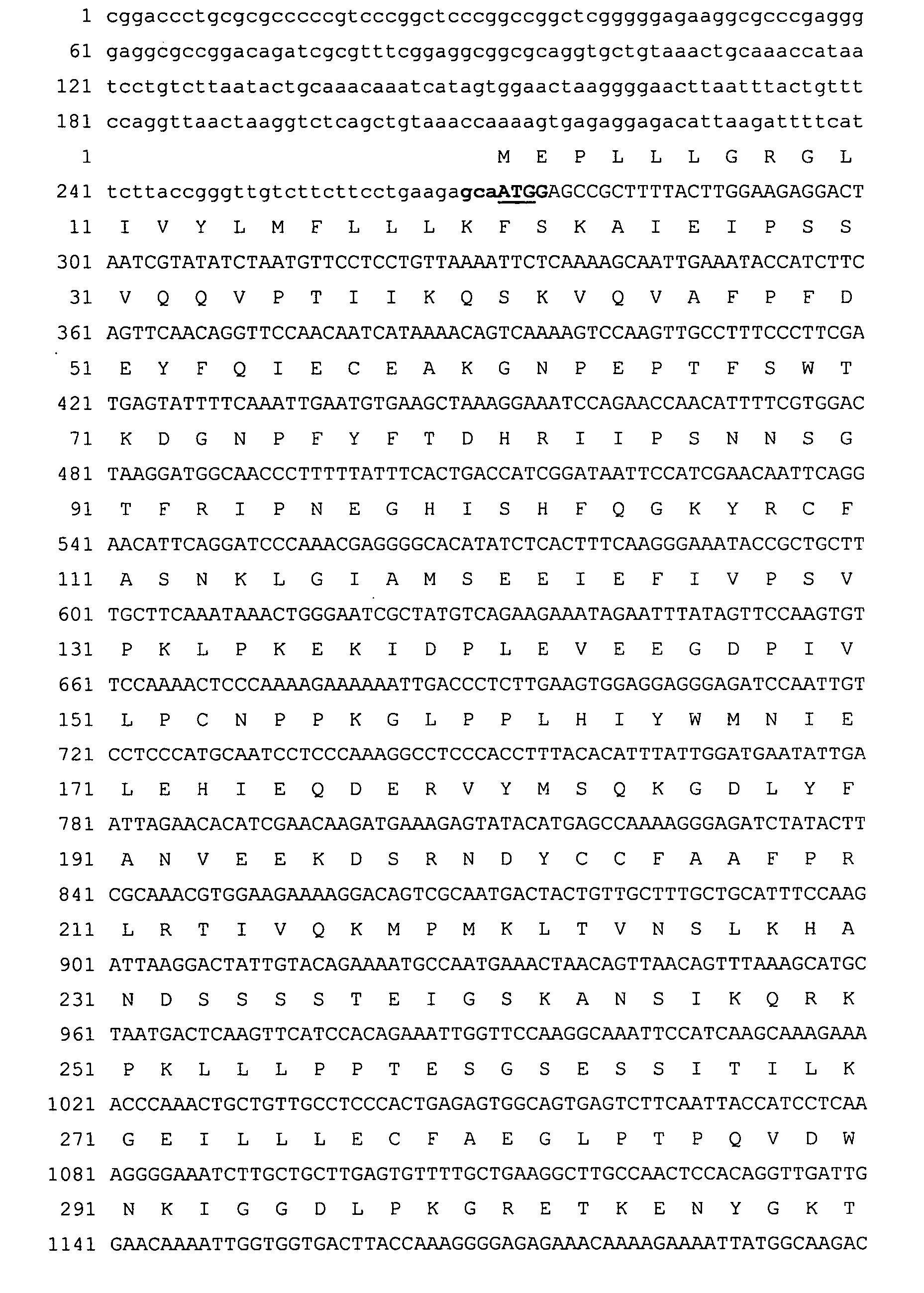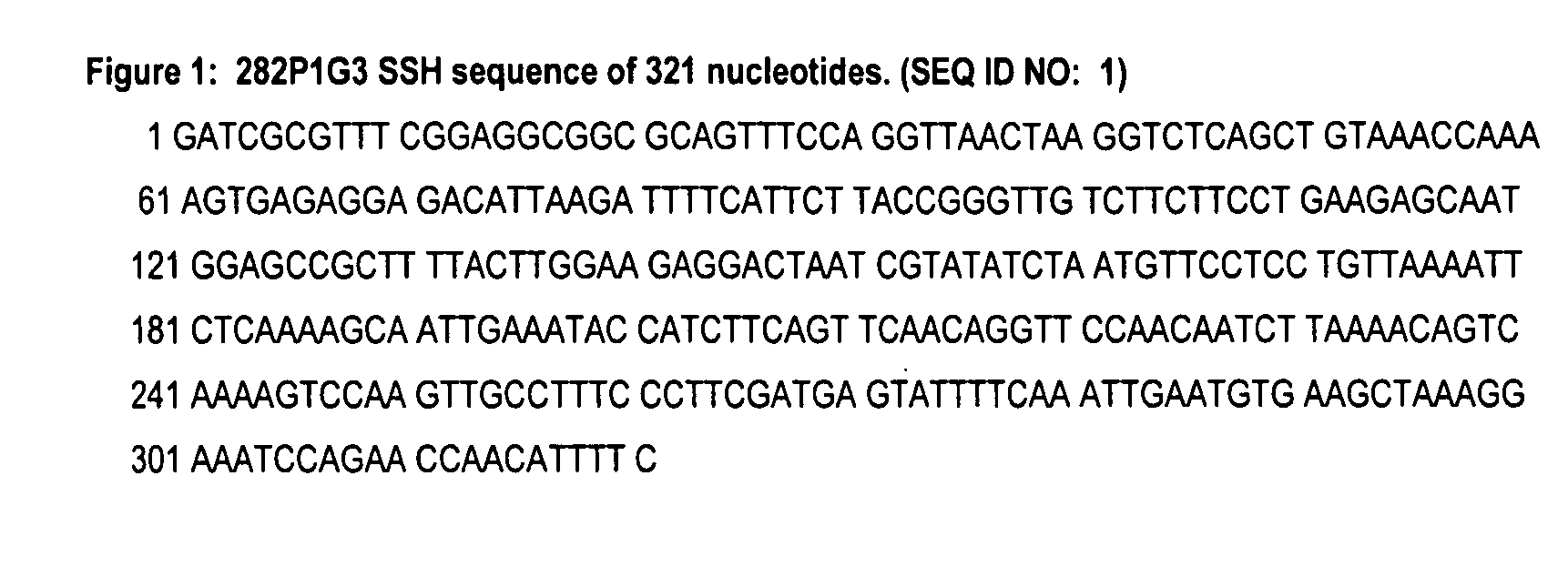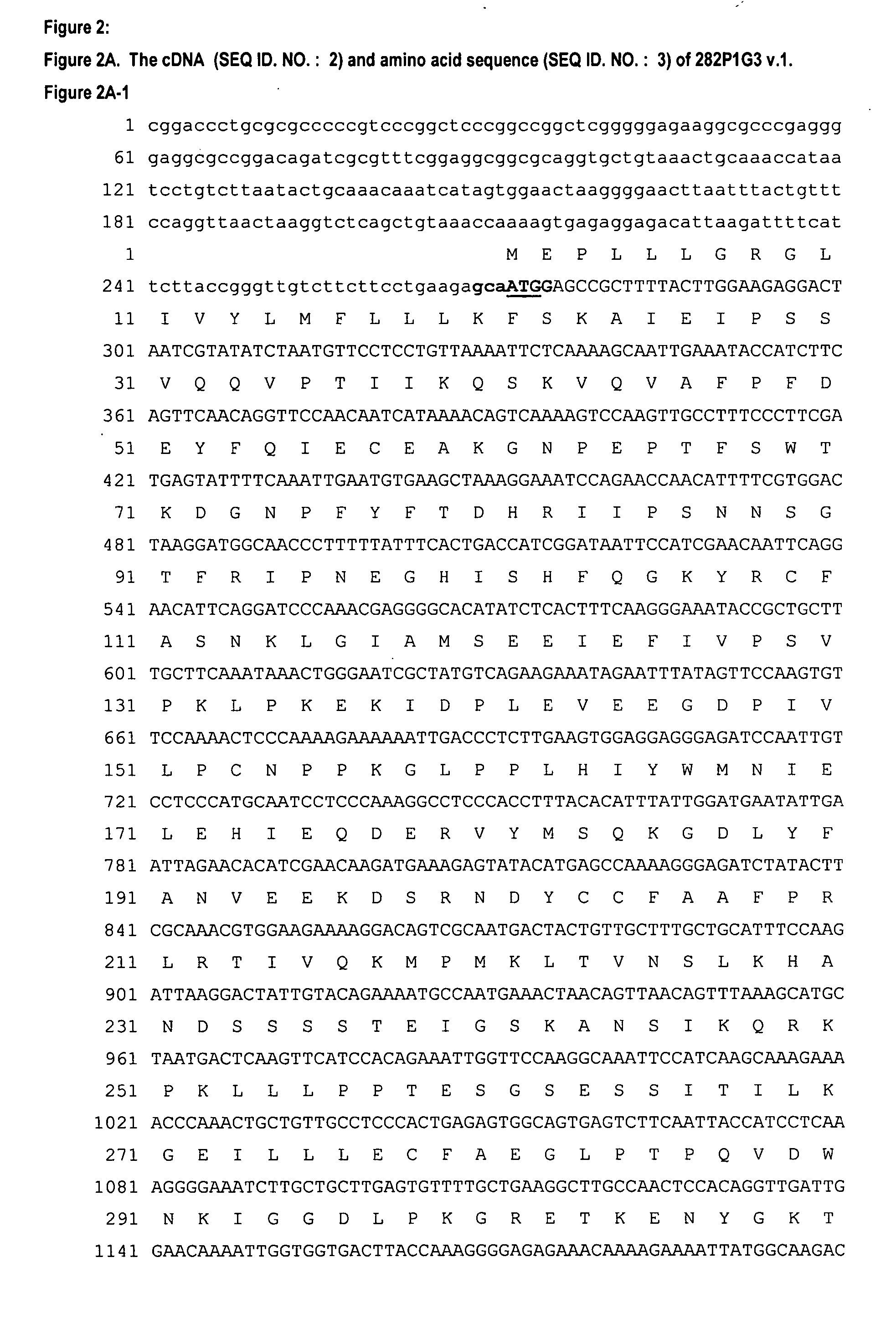Nucleic acids and corresponding proteins entitled 282P1G3 useful in treatment and detection of cancer
a technology of nucleic acids and corresponding proteins, applied in the direction of fusion polypeptides, peptide/protein ingredients, depsipeptides, etc., can solve the problems of ineffective treatment of many patients, undesirable consequences, and still no effective treatment for metastatic prostate cancer
- Summary
- Abstract
- Description
- Claims
- Application Information
AI Technical Summary
Benefits of technology
Problems solved by technology
Method used
Image
Examples
example 1
SSH-Generated Isolation of cDNA Fragment of the 282P1G3 Gene
[0686] To isolate genes that are over-expressed in pancreatic cancer we used the Suppression Subtractive Hybridization (SSH) procedure using cDNA derived from pancreatic cancer tissues. The 282P1G3 SSH cDNA sequence was derived from pancreatic tumor minus cDNAs derived from normal pancreas. The 282P1G3 cDNA was identified as highly expressed in the pancreas cancer.
[0687] Materials and Methods
[0688] Human Tissues:
[0689] The patient cancer and normal tissues were purchased from different sources such as the NDRI (Philadelphia, Pa.). mRNA for some normal tissues were purchased from Clontech, Palo Alto, Calif.
[0690] RNA Isolation:
[0691] Tissues were homogenized in Trizol reagent (Life Technologies, Gibco BRL) using 10 ml / g tissue isolate total RNA. Poly A RNA was purified from total RNA using Qiagen's Oligotex mRNA Mini and Midi kits. Total and mRNA were quantified by spectrophotometric analysis (O.D. 260 / 280 nm) and anal...
example 2
Isolation of Full Length 282P1G3 Encoding cDNA
[0710] The 282P1G3 SSH cDNA sequence was derived from a subtraction consisting of pancreas cancer minus a normal pancreas. The SSH cDNA sequence of 321 bp (FIG. 1) was designated 282P1G3.
[0711] 282P1G3 v.2 of 3464 bp was cloned from a pool of normal tissue cDNA library, revealing an ORF of 1171 amino acids (FIG. 2 and FIG. 3). Other variants of 282P1G3 were also identified and these are listed in FIG. 2 and FIG. 3.
[0712] 282P1G3 v.1, v.9, v.10, v.11, v.24 and v.25 proteins are 1224 amino acids in length and differ from each other by one amino acid as shown in FIG. 11. 282P1G3 v.12 through v.23, v.26 and v.27 are SNP variants and code for the same protein as 282P1G3 v.1. 282P1G3 v.2, v.3, v.4, v.5, v.6, v.7, and v.8 are splice variants of 282P1G3 v.1 and code for proteins of 1171, 893, 1117, 1208, 1183, 1236, and 1195 amino acids, respectively. 282P1G3 v.28 is a splice variant identified by the 282P1G3 SSH, and deletes the second exon ...
example 3
Chromosomal Mapping of 282P1G3
[0714] Chromosomal localization can implicate genes in disease pathogenesis. Several chromosome mapping approaches are available including fluorescent in situ hybridization (FISH), human / hamster radiation hybrid (RH) panels (Walter et al., 1994; Nature Genetics 7:22; Research Genetics, Huntsville Ala.), human-rodent somatic cell hybrid panels such as is available from the Cornell Institute (Camden, N.J.), and genomic viewers utilizing BLAST homologies to sequenced and mapped genomic clones (NCBI, Bethesda, Md.).
[0715] 282P1G3 maps to chromosome 3p26.1 using 282P1G3 sequence and the NCBI BLAST tool located on the World Wide Web at: (.ncbi.nim.nih.gov / genome / seq / page.cgi?F=HsBlast.html&&ORG=Hs).
PUM
| Property | Measurement | Unit |
|---|---|---|
| composition | aaaaa | aaaaa |
| nucleic acid | aaaaa | aaaaa |
Abstract
Description
Claims
Application Information
 Login to View More
Login to View More - R&D
- Intellectual Property
- Life Sciences
- Materials
- Tech Scout
- Unparalleled Data Quality
- Higher Quality Content
- 60% Fewer Hallucinations
Browse by: Latest US Patents, China's latest patents, Technical Efficacy Thesaurus, Application Domain, Technology Topic, Popular Technical Reports.
© 2025 PatSnap. All rights reserved.Legal|Privacy policy|Modern Slavery Act Transparency Statement|Sitemap|About US| Contact US: help@patsnap.com



